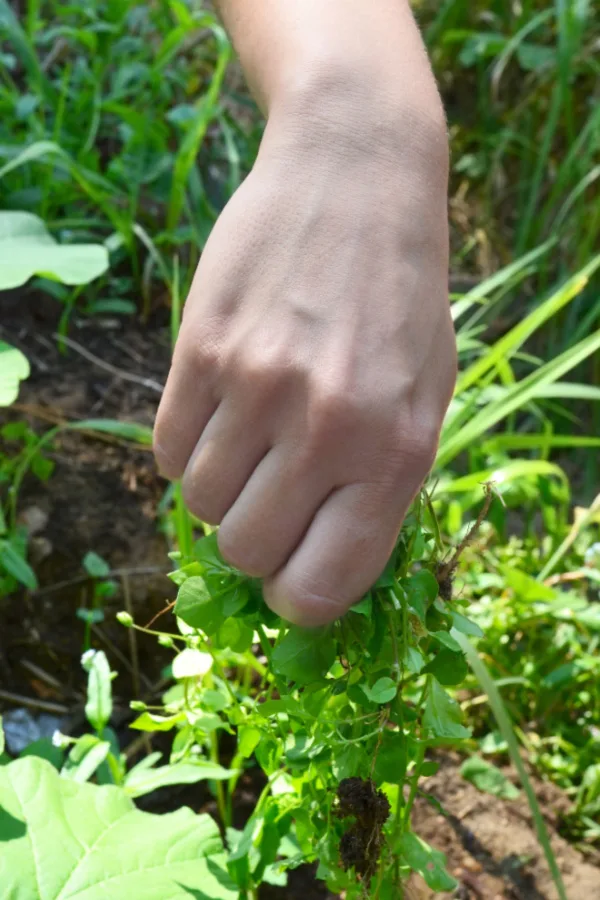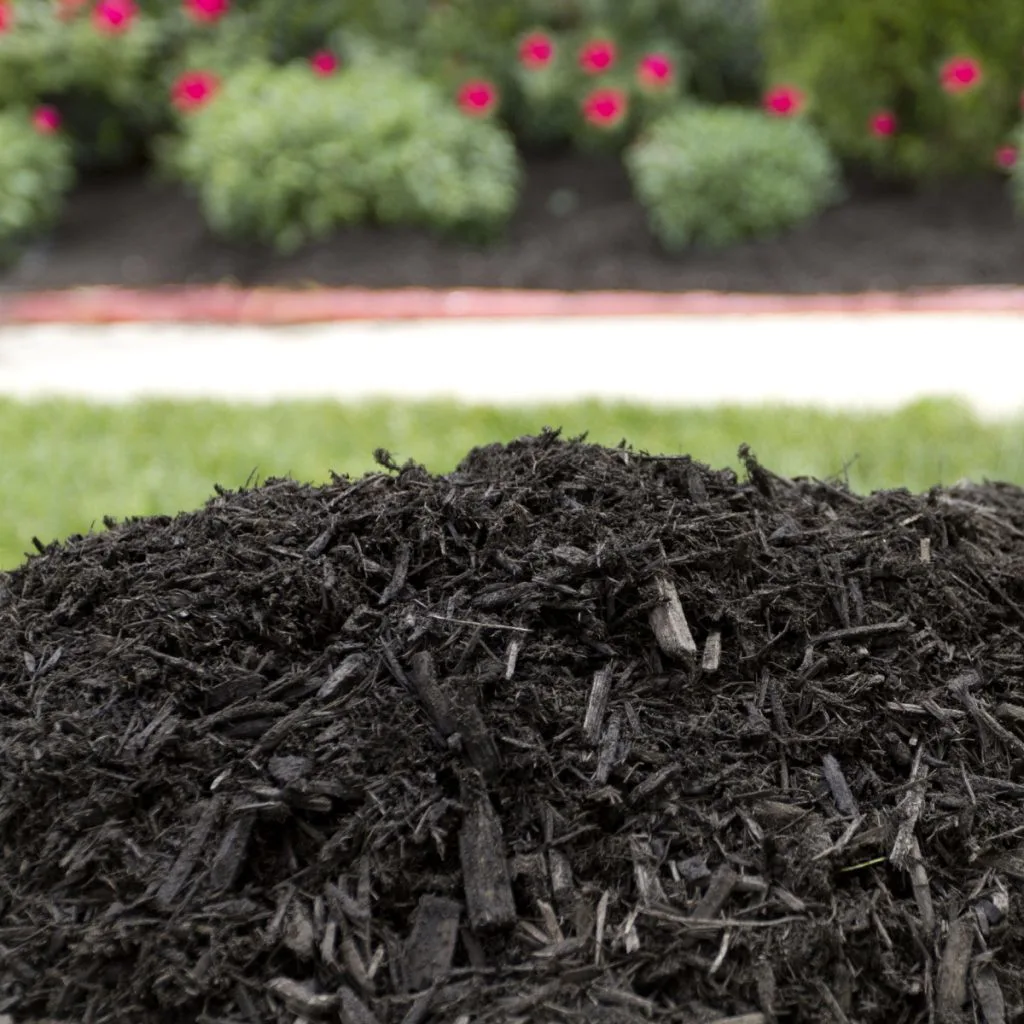Looking for a few simple tips to get rid of all of that chickweed that’s appearing in your flowerbeds this fall and winter? And how to keep it out for good?
Chickweed might look soft and harmless at first glance, but anyone who has battled it in their flowerbeds knows just how persistent this little plant can be. It spreads fast, grows in thick mats, and takes advantage of cool temperatures in a way that makes fall and winter one of the most important times to stay ahead of it.
The good news? Getting rid of chickweed doesn’t have to involve chemicals or complicated methods. In fact, with a little understanding of how this weed grows and what helps it thrive, you can eliminate it naturally and set your flowerbeds up for a much better spring.

How To Get Rid Of Chickweed In Your Flowerbeds
Chickweed is a cool-season annual weed. That means it grows best when the rest of the garden is slowing down. While most weeds wait for warmer weather, chickweed begins to germinate in late fall and can continue to sprout throughout the winter whenever temperatures rise just a little and the soil remains moist.
Because of its growth pattern, many gardeners think it only shows up in early spring. The truth is, by the time you see it then, most of it has already been growing for months underneath fallen leaves, mulch, or open soil.
And that is exactly why tackling chickweed in fall and winter is so important. Once you understand what chickweed is, how it spreads, and what natural methods work best against it, you can finally stop it from overtaking your flowerbeds each year.
What Chickweed Is – And Why It Thrives In Cooler Weather
Chickweed is a low-growing weed that forms dense mats of bright green leaves and tiny white flowers. It prefers cool, damp conditions, which is the opposite of many other common annual weeds.

There are two common types: common chickweed and mouse-ear chickweed. Both behave similarly, but common chickweed is usually softer and forms thicker mats. Mouse-ear chickweed tends to have slightly fuzzier leaves.
The reason chickweed is so tough to control is because it germinates and spreads in conditions when most gardeners aren’t paying much attention to their flowerbeds. Once fall arrives and the weather turns chilly, chickweed seeds start sprouting. And it can keep growing all winter long as long as the ground isn’t frozen.
Chickweed seeds can also lay dormant in your soil for years. Those seeds drop into flowerbeds, get buried by mulch, and wait for the cool, moist conditions that fall and winter provide. And because chickweed grows low and stays low, light layers of mulch or leaves often aren’t enough to stop it.
How Chickweed Spreads So Quickly – And How To Get Rid Of It!
Chickweed spreads in three major ways: seeds, rooted stems, and mat-like growth. The seeds are the biggest long-term problem because each plant produces so many.
But chickweed also spreads through its stems. If a stem touches the soil, it can root. This can lead to new plants forming all along the edges of a small patch. Before you know it, that patch can double or triple in size. Because the plant grows close to the ground, it hugs the soil and avoids frost damage that often harms other weeds.

Another reason chickweed gets out of control is that it loves disturbed soil. Anytime the soil is exposed, whether from weeding, digging, raking, or a light layer of mulch blowing away, chickweed sees an open opportunity. Weed seeds thrive on bare soil, and chickweed is especially good at taking advantage.
By the time spring arrives, the compact green mat you see is usually the end result of months of growth. That is why it’s so important to address chickweed during the fall and winter when it’s most vulnerable.
Why Natural Control Works Best
Although chemical sprays exist for chickweed, they often fail for two main reasons. First, sprays have a hard time penetrating the thick mats the weed forms. Second, cool weather reduces the effectiveness of many herbicides. That makes fall and winter the worst time to rely on chemicals to get rid of chickweed.
Natural methods, on the other hand, work with the seasons. Chickweed may be persistent, but it has weaknesses. It cannot handle heavy layers of organic mulch, consistent bed coverage, or disturbed roots that are pulled up entirely. It also struggles when beds remain well-mulched and the soil is not exposed.
What makes natural control effective is the fact that chickweed has such a shallow root system. It grows fast, but the roots do not dig deep. They sit close to the surface and pull up easily when the soil is moist. That makes hand removal, smothering, and mulching highly effective options during fall and winter.

Hand-Pulling While The Soil Is Moist
One of the easiest and most effective ways to eliminate chickweed is simply pulling it out by hand. Because it has a shallow root system, chickweed comes up easily when the soil is damp. Cool, wet fall and winter days are perfect for pulling it. Grab the plant at the base and pull gently. The entire root system often comes out in one motion.
The key is to remove the plant before tiny white flowers appear. Once it flowers, it will quickly begin producing seeds. Even if you accidentally tear the plant while pulling, the root system is usually weak enough that it doesn’t regrow well after being disturbed.
Make sure to pull chickweed patches as soon as you spot them. Even small clumps can produce huge amounts of seed if left alone.
Smother With A Thick Layer Of Mulch
Mulching is one of the most powerful tools you have to get rid of chickweed. Because chickweed seeds need light to germinate, deep mulch keeps the seeds from sprouting. A two-inch layer of mulch is not enough, however. Chickweed can sometimes push right through. See: Why You Need To Mulch Flowerbeds In The Fall – How To Stop Next Year’s Weeds Now!
For fall and winter protection, apply a four- to six-inch layer of mulch in your flowerbeds, especially in open areas between perennials. Straw, shredded leaves, composted bark, wood chips, or pine needles all work well. Not only does this prevent chickweed from germinating, but it also protects your existing plants from temperature swings.
Chickweed also cannot survive being smothered. If you already have patches starting to grow, bury them under a heavy layer of mulch. This blocks light and prevents the plants from photosynthesizing. Within a few weeks, the chickweed will weaken and die back.

Using Cardboard Or Paper As A Weed Blocker
If you have an area with heavy chickweed pressure, place cardboard or several sheets of overlapping newspaper directly on the soil. Then cover it with mulch. This combination blocks the light and smothers the weed from above while also keeping seeds below from germinating.
This method works extremely well in fall and winter because the layers stay moist, which causes the cardboard or paper to break down slowly over time. As it decomposes, it enriches your soil while depriving chickweed of the light it needs to grow. It’s one of the simplest long-term solutions for persistent beds.
Keep Those Flowerbeds Covered!
One of the biggest mistakes gardeners make is leaving soil exposed during the fall and winter months. Bare soil is an open invitation for chickweed. To stop future infestations, keep your flowerbeds covered year-round.
Add mulch, plant ground covers, or leave winter foliage from perennials in place until spring. Even a temporary cover of shredded leaves can help block seeds from germinating.
The more covered your soil is, the more likely you are to get rid of chickweed. This one step alone can drastically reduce the number of chickweed plants you see throughout the winter and early spring.
Last but not least, keep your beds as dry as you can. Chickweed thrives in moist, shaded soil. Improving drainage in your flowerbeds can make the environment far less appealing. Avoid overwatering during the fall, especially as temperatures drop.
Here is to getting rid of chickweed once and for all this fall and winter!
This Is My Garden
Follow Our Facebook Page For Great Gardening Tips And Advice! This Is My Garden Facebook Page
This Is My Garden is a garden website created by gardeners, for gardeners. Jim and Mary Competti have been writing gardening, DIY and recipe articles and books and speaking for over 15 years from their 46 acre Ohio farm. They publish three articles every week, 52 weeks a year. Sign up today to follow via email, or follow along!
